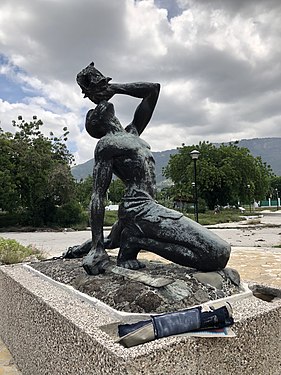Le Marron Inconnu
 | |
 | |
| 18°32′41″N 72°20′16″W / 18.5446°N 72.3377°W | |
| Location | Place du Marron Inconnu, Champ de Mars, HT6110 Port-au-Prince, Haiti[1] |
|---|---|
| Designer | Created by Haitian sculptor Albert Mangonès |
| Height | 3.60 metres (11.8 ft) and 2.40 metres (7.9 ft) tall |
| Completion date | 22 September 1967[2][3] |
| Dedicated to | Abolishment of slavery and freedom of all black people |
Le Marron Inconnu de Port au prince,[4] shortened as Le Marron Inconnu (French pronunciation: [lə ma.ʁɔ̃ ɛ̃.kɔ.ny], "The Unknown Maroon"), also called Neg Marron or Nèg Mawon (Haitian Creole pronunciation: [nɛɡ ma.ʁɔ̃], "Maroon Man"),[5][6] is a bronze statue of a runaway slave, better known as a maroon, standing in the center of Port-au-Prince, Haiti. Completed on September 22 1967 by Haitian architect Albert Mangonès, the statue is regarded as a symbol of black liberation;[7] commemorating in particular, the rallying cry that sparked the Haitian Revolution and the abolishment of slavery. Situated across from the National Palace,[8] it is the nation's most iconic representation of the struggle for freedom.[1][9]
Description
Mangonès completed the statue on 22 September 1967.[2] It measures 3.60 metres long by 2.40 metres high.[10] It depicts in bronze a near-naked fugitive black man, kneeling on one knee, his torso arched, his opposite leg stretched back, and a broken chain on his left ankle. He holds a conch shell at his lips with his left hand, his head tilted upward to blow it, while the other hand holds a machete on the ground by his right ankle.[5][6][10]
Mangonès chose a passage from 1 Maccabees 14:3-9 of the Jerusalem Bible to be set in copper letters on one of the two concrete panels that protect the "eternal flame" of freedom in the square surrounding the statue.[10]
Recognized usage
In 1989, the United Nations adopted the statue as a central icon on postage stamps commemorating Article 4 of the Universal Declaration of Human Rights that states, "No one shall be held in slavery or servitude; slavery and the slave trade shall be prohibited in all their forms."[1][9][11][12]
Gallery
Text is available under the CC BY-SA 4.0 license; additional terms may apply.
Images, videos and audio are available under their respective licenses.




